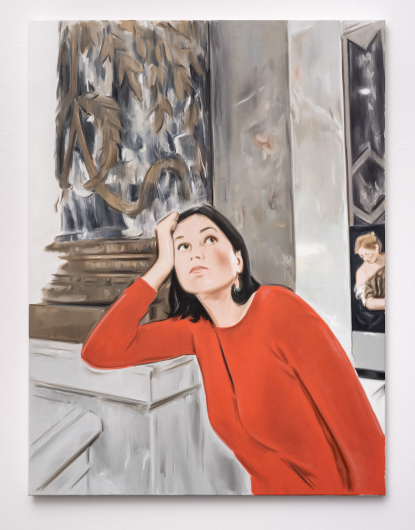Two Epochs
September 21, 2024 – January 5, 2025
The display of two paintings from the artist’s oeuvre takes us into his world where contemporary art meets ancient art. Both paintings refer to the presence of the contemporary viewer in museum interiors (at Pieskowa Skała Castle and Kunsthistorisches Museum in Vienna, respectively), supplementing the historic paintings presented in the old rooms of Wawel Castle and providing a counterpoint to them. In the foreground of both of them, there are women representing two different epochs – the wife of Sigismund III Vasa, frozen in a dignified, representative pose, and a contemporary woman, pensive and shown in a casual pose.
The display of two paintings from the artist’s oeuvre takes us into his world where contemporary art meets ancient art. Both paintings refer to the presence of the contemporary viewer in museum interiors (at Pieskowa Skała Castle and Kunsthistorisches Museum in Vienna, respectively), supplementing the historic paintings presented in the old rooms of Wawel Castle and providing a counterpoint to them. In the foreground of both of them, there are women representing two different epochs – the wife of Sigismund III Vasa, frozen in a dignified, representative pose, and a contemporary woman, pensive and shown in a casual pose.

The painting Constance of Austria (Pieskowa Skała Castle) is inspired by a 19th-century copy of the portrait of Constance Habsburg (inv. no. ZKnW-PZS 8557), seen during the Long Night of Museums at Pieskowa Skała Castle. The 17th-century original is in the collection of Wawel Royal Castle (inv. no. ZKnW-PZS 1783). ‘I was drawn to this large, almost abstract, dark, undulating canvas in a room full of visitors,’ says the artist. In Maciejowski’s personal interpretation of the painting, it is shown not directly, but from behind the head of an anonymous contemporary viewer looking at the work hanging on the wall, from a perspective in which the figure of the princess became somehow monumental. In this version, her image supplements and provides a counterbalance to the male gallery of historical representational portraits present in the Battle of Orsha Hall.
Constance of Austria (Pieskowa Skała Castle), 2019
oil on canvas, 160 × 120 cm
thanks to the courtesy of Thaddaeus Ropac Gallery
Constance of Austria (Pieskowa Skała Castle), 2019
oil on canvas, 160 × 120 cm
thanks to the courtesy of Thaddaeus Ropac Gallery

The fact that the scene from the second work takes place in a museum interior is evidenced by a firstly unnoticeable fragment of Paolo Veronese’s painting Lucrezia. However, it is not the antique heroine who catches the eye, but the figure of a pensive woman turned away from the painting. Her upward gaze makes us want to see what she is looking at, even though the object is already out of the frame. Placing this particular work by Marcin Maciejowski in the Under the Birds Room at Wawel Castle is, as the artist himself emphasises, extremely important to him: ‘I am discovering the painting of the 1920s and 1930s on the Wawel plafonds – Pronaszko, Waliszewski, Weiss, Jarema, and Kowarski. Each of them, like me, looked for a context in ancient art and referred to Antiquity in their themes. The figure in my painting looks up at their achievements, literally and metaphorically,’ reminding the visitors to this and subsequent halls of the royal castle to lift their heads up.
The Rest of Reality Seems Too Abstract at the Moment
oil on canvas, 160 × 120 cm
thanks to the courtesy of Raster Gallery
The Rest of Reality Seems Too Abstract at the Moment
oil on canvas, 160 × 120 cm
thanks to the courtesy of Raster Gallery
About the Artist
Marcin Maciejowski (b. 1974) – painter and drawing artist, graduate of the Academy of Fine Arts in Krakow, winner of the Passports of ‘Polityka’ prize. In 2000–2010, he collaborated with the Przekrój magazine – he created covers and illustrations, and in his personal column, he commented on the Polish reality – art, sport, and politics – in drawings. Maciejewski’s works stay in open dialogue both with the contemporary time, everyday activities, mass cultures, and art history, especially, the history of old masters’ paintings.
Media Patron of the Painting Intervention


